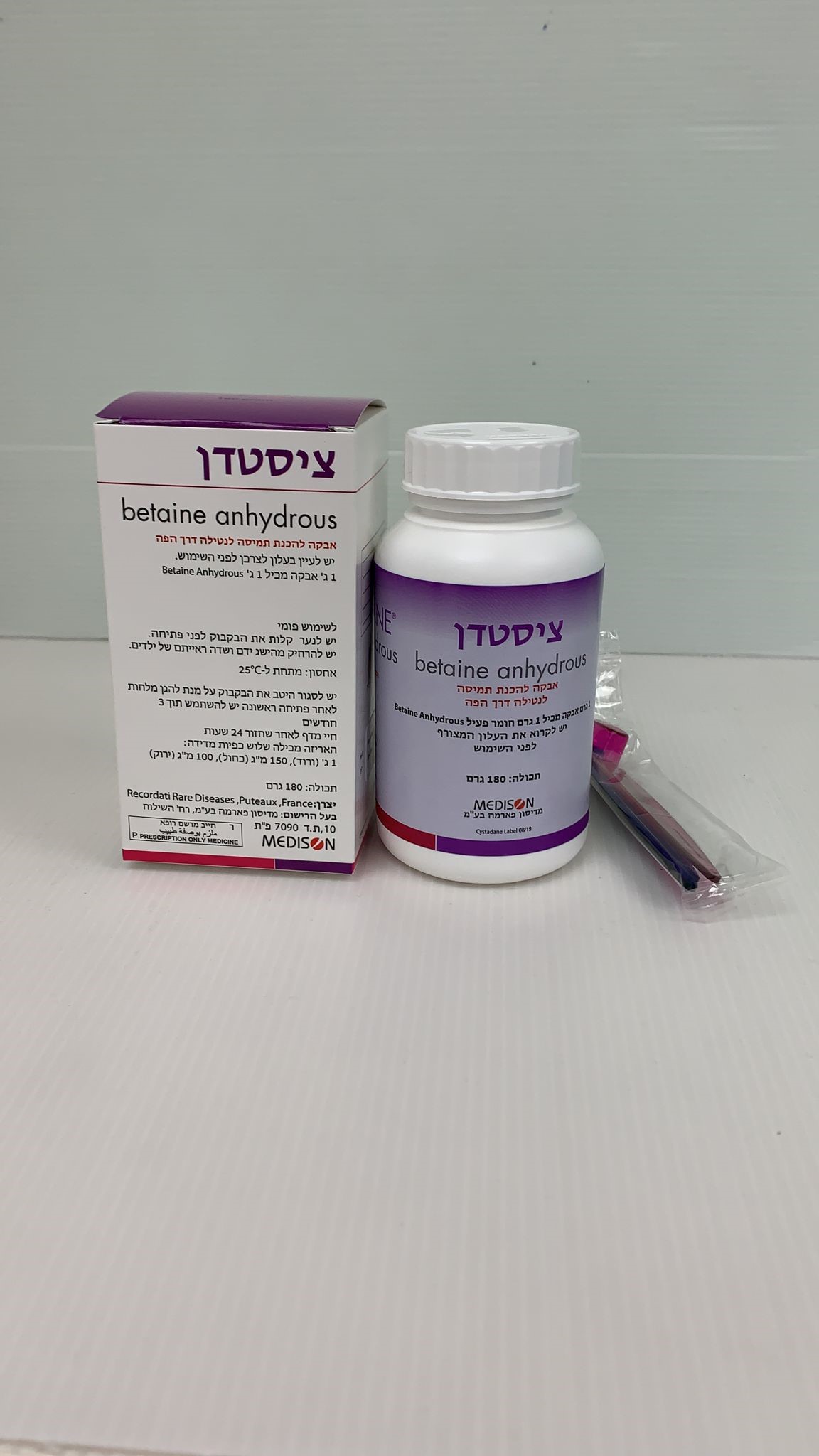Quest for the right Drug

ציסטדן CYSTADANE (BETAINE ANHYDROUS)
תרופה במרשם
תרופה בסל
נרקוטיקה
ציטוטוקסיקה
צורת מתן:
פומי : PER OS
צורת מינון:
אבקה להכנת תמיסה : POWDER FOR SOLUTION
עלון לרופא
מינוניםPosology התוויות
Indications תופעות לוואי
Adverse reactions התוויות נגד
Contraindications אינטראקציות
Interactions מינון יתר
Overdose הריון/הנקה
Pregnancy & Lactation אוכלוסיות מיוחדות
Special populations תכונות פרמקולוגיות
Pharmacological properties מידע רוקחי
Pharmaceutical particulars אזהרת שימוש
Special Warning עלון לרופא
Physicians Leaflet
Pharmacological properties : תכונות פרמקולוגיות
Pharmacodynamic Properties
5.1 Pharmacodynamic properties Pharmacotherapeutic group: Other alimentary tract and metabolism products, ATC code: A16AA06. Mechanism of action Betaine anhydrous was shown to lower plasma homocysteine levels in the three types of homocystinuria, i.e. CBS deficiency; MTHFR deficiency and cbl defect. The extent of this effect was dependent on the absolute degree of hyperhomocysteinemia, being higher in severe hyperhomocysteinemia. Pharmacodynamic effects Betaine anhydrous acts as a methyl group donor in the remethylation of homocysteine to methionine in patients with homocystinuria. As a result, plasma levels of homocysteine should decrease in these patients, to 20-30 % of pre-treatment levels. Betaine anhydrous has also been shown to increase plasma methionine and S-adenosyl methionine (SAM) levels in patients with MTHFR deficiency and cbl defects. In CBS- deficient patients without dietary restriction of methionine, excessive accumulation of methionine has been observed. Betaine anhydrous supplementation was shown to improve the metabolic abnormalities in the cerebrospinal fluid of patients with homocystinuria. Clinical efficacy and safety Elevated homocysteine plasma levels are associated with cardiovascular events (such as thrombosis), osteoporosis, skeletal abnormalities, and optic lens dislocation. In observational studies, clinical improvement (cardiovascular and neurodevelopmental) was reported by the treating physician in about 75% of patients taking betaine anhydrous. Most of these patients were also receiving other treatments such as vitamin B6 (pyridoxine), vitamin B12 (cobalamin) and folate with variable biochemical responses. In most cases, adding betaine anhydrous resulted in a further reduction in plasma homocysteine level. It is likely that due to the multiple nature of therapy (dietary, pharmaceutical, supportive) in these patients, there may be an element of overestimation in the clinical effects of betaine anhydrous treatment. Late detection of homocystinuria in symptomatic state is responsible for residual morbidity due to irreversible damage to connective tissue (ophtalmological, skeletal) that cannot be corrected by further therapy. The available clinical data do not allow correlating posology and clinical efficacy. There is no evidence of development of tolerance. In a few cases, increased plasma methionine levels were associated with cerebral oedema (see sections 4.4 and 4.8). Monitoring plasma homocysteine levels has demonstrated that the onset of action of betaine anhydrous occurred within several days and that a steady-state response was achieved within one month. Paediatric population In paediatric patients less than 10 years of age, the usual effective dose regimen is 100 mg/kg/day given in 2 doses daily; increasing the frequency above twice daily and/or the dose above 150 mg/kg/day does not improve the homocysteine-lowering effect. Monitoring betaine plasma concentrations does not help to define the efficacy of treatment, since these concentrations do not directly correspond to the flux through the cytosolic betaine homocysteine methyl transferase pathway.
Pharmacokinetic Properties
5.2 Pharmacokinetic properties The pharmacokinetic data of homocystinuric patients on long-term betaine anhydrous supplementation are very similar to those of healthy volunteers. This demonstrates that differences in betaine anhydrous kinetics are most probably due to betaine anhydrous depletion in untreated homocystinuria and are only meaningful for the initial treatment. Absorption The absolute bioavailability of betaine anhydrous has not been determined. In healthy adult volunteers (age between 21 to 49 years), after a single oral dose of betaine anhydrous (50 mg/kg), absorption was rapid (tmax = 0.9 ± 0.3 hours and a Cmax = 0.9 ± 0.2 mM). After a repeated dose regimen of 100 mg/kg/day for 5 days, the absorption kinetics did not change. Distribution Betaine anhydrous was rapidly distributed into a relatively large volume (V/F = 1.3 l/kg). After a repeated dose regiment of 100 mg/kg/day for 5 days, the distribution half life was prolonged significantly (up to 36 h), indicating saturable transport and redistribution processes. Biotransformation Betaine anhydrous is a methyl group donor Elimination With a slow elimination rate (mean half life = 14 h, mean total body clearance, CL/F, = 84 ml/h/kg), renal clearance is negligible (5% of total body clearance), assuming 100% bioavailability.

שימוש לפי פנקס קופ''ח כללית 1994
לא צוין
תאריך הכללה מקורי בסל
01/01/2000
הגבלות
תרופה מוגבלת לרישום ע'י רופא מומחה או הגבלה אחרת
מידע נוסף
